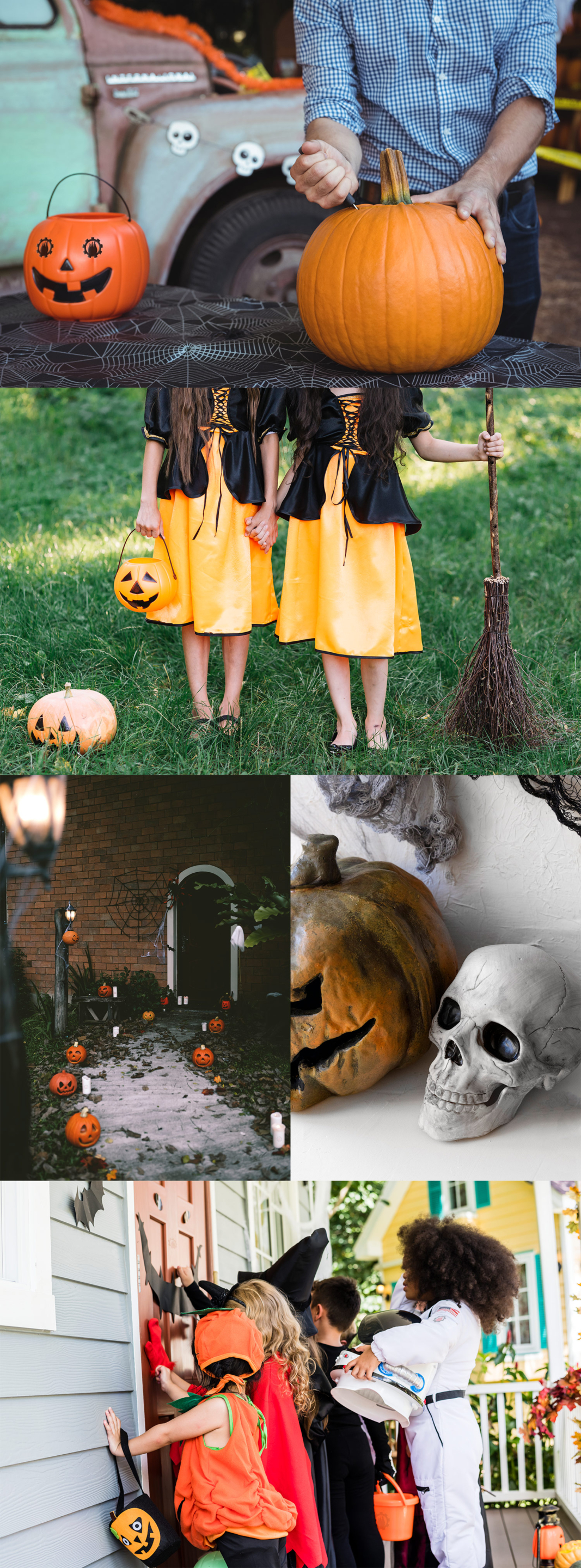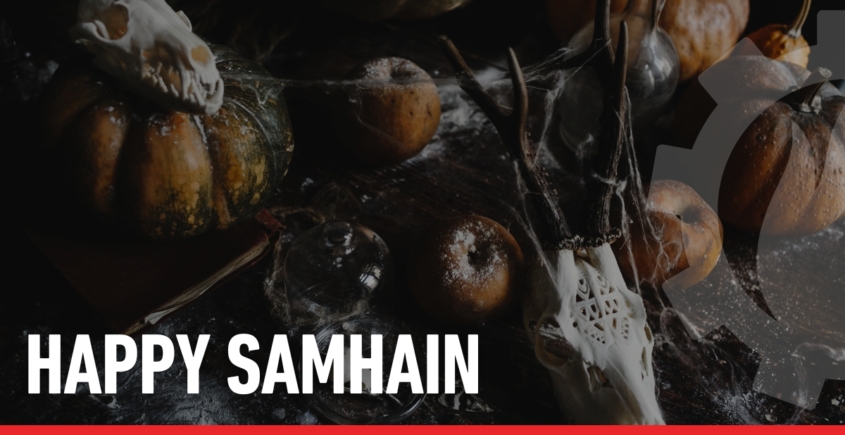Happy Samhain!
Today marks one of my favorite celebrations of the year – Halloween. I have so many great memories as a kid – picking out my costumes, decorating the house, running the neighborhood with my siblings and buddies, making sure the neighbors 10 doors down could hear us yelling “Trick or Treat”, sorting candy on the living room floor, and enjoying the treats for weeks to come (all-time favorite candy: Reese’s Peanut Butter Cups, Snickers, 100 Grand Bar and of course Peanut M & M’s!!) Halloween may look like candy, costumes, decorations and carved pumpkins, but I found out its roots stretch back more than 2,000 years to the ancient Celtic festival of Samhain (SOW-in). I always love digging for new information!!!! This was no lighthearted holiday: while it marked the end of harvest and the beginning of winter, the night had deeper meanings – when the veil between the living and the dead was at its thinnest. Over time, Samhain’s symbols and superstitions evolved through Christian influence, folklore, and immigration – shaping the traditions and imagery we know today. I decided to dig in and really learn about the day, and its heritage (thanks, Library of Congress!!) Here’s just some of what I found out. ENJOY!

Fun Halloween music to enjoy while reading!
The tradition dates all the way back to the Celts, who divided their year by great fire festivals, each celebrating a seasonal shift: Imbolc (Feb 1–2): The first stirrings of spring, tied to the goddess Brigid. Beltane (May 1): Summer’s start, with bonfires lit to bless crops and livestock. Lughnasadh (Aug 1): The first harvest, honoring the god Lugh with feasts and games. And Samhain (Oct 31–Nov 1): The year’s end, the final harvest, and the gateway into winter’s dark half. Among these, Samhain was the most mysterious and feared – a night of spirits, fire, and fate. Learn More.
Samhain was the Celtic New Year, when summer’s light gave way to winter’s darkness. People believed the veil between worlds grew thin, allowing ancestors to return – but also letting darker forces slip through. Bonfires were lit to drive off evil, and hearth fires were rekindled for protection. Families left offerings of food and drink to welcome their dead and appease the fairy folk, or Aos Sí, who roamed freely. People wore disguises to hide from harmful spirits, a practice that planted the seed for today’s costumes (now you know!).
Samhain was firmly established as a harvest and death-rebirth festival during the Iron Age (500BC-400AD). In the 5th-9th centuries, Samhain blended with All Saints’ Day (Nov 1) and All Souls’ Day (Nov 2). Death and remembrance remained central, even under new names. As folklore grew during Medieval times, stories of wandering spirits, divination rituals, and the mischievous fairy folk emerged. “Souling” (prayers for the dead in exchange for food) began, and in the 16th and 18th centuries, Irish and Scottish people practiced guising – dressing in costumes to confuse the spirits. Irish immigrants brought these customs to America, and pumpkins replaced turnips. Trick-or-treating became popular after World War II. Many of the traditions and images have found their way into modern times:
Pumpkins & Jack-o’-Lanterns
- The tradition began in Ireland and Scotland, where people carved faces into turnips, beets, and potatoes to ward off evil spirits. The name “jack-o’-lantern” comes from an Irish folktale about Stingy Jack, who tricked the Devil and was doomed to wander the earth with only a carved turnip lantern. Pumpkins became popular in America because they were larger, softer, and easier to carve.
Candles & Lanterns
- Bonfires and candles were originally lit during Samhain (Celtic festival) to guide the spirits of loved ones and scare away malicious ones. Placing a candle in the window was believed to help wandering souls find their way home.
Owls & Bats
- In Celtic and medieval folklore, owls were thought to be messengers from the spirit world. Some European traditions claimed that hearing an owl’s call meant someone nearby would die. Conversely, in Native American culture, owls could represent wisdom, foresight, or protection.
- Bats became linked to Halloween because bonfires at Samhain attracted insects, which then drew bats. In medieval folklore, bats flying close to a house were thought to signal the presence of spirits or witches. Vampires (especially in Eastern European legends) were sometimes believed to transform into bats, cementing their spooky connection.
Black Cats & Spiders
- Ancient Egyptians revered black cats as sacred. By the Middle Ages in Europe, black cats became linked to witches, believed to be witches’ familiars or even witches in disguise. Crossing paths with a black cat was said to bring bad luck because it meant a witch was watching you. Early European folklore said witches could turn into cats to sneak around unseen, cementing the black cat’s spooky reputation.
- Spiders were seen as protectors in folklore – their webs connected the earthly world with the spiritual. In medieval superstition, seeing a spider on Halloween night meant a loved one’s spirit was nearby. Witches were believed to keep spiders as helpers in potion-making.
Witches & Brooms
- The image of witches flying on broomsticks likely comes from medieval fertility rituals, where people “rode” poles through fields to encourage crop growth. Witches were said to gather on Halloween night to celebrate with the Devil. The classic “pointed hat” may trace back to tall conical hats worn by women in medieval Europe. Halloween magnifies the folklore of midnight (Witching Hour) as the time when supernatural forces are most active.
Skeletons & Skulls
- Skeletons represent the cycle of life and death, and at Halloween, they symbolize the dead returning. The skull is one of the oldest symbols of mortality, used in rituals and a reminder of the inevitability of death (memento mori). In Mexico’s Día de los Muertos, skulls (calaveras) represent playful remembrance, not fear.
Cobwebs & Haunted Houses
- Cobwebs in abandoned homes came to symbolize decay and neglect, common imagery in ghost stories. Folklore suggested that if cobwebs appeared suddenly indoors, it meant spirits were present.
The Moon
- A full moon on Halloween is rare (every 18-19 years) and often tied to superstitions about heightened supernatural activity. In folklore, the moon was believed to be a gateway for spirits, making Halloween even more mystical when it coincided with a full moon. Many horror stories and films use the harvest moon as an ominous backdrop.
Trick-or-Treat
- The practice has roots in “souling” (medieval England), where poor people went door-to-door offering prayers for the dead in exchange for food. In Scotland and Ireland, children practiced “guising,” dressing up in disguise and performing songs or tricks for treats. The first written reference to “trick-or-treating” in North America appeared in 1927 in Blackie, Alberta, Canada. The candy-for-costumes tradition didn’t become widespread in the U.S. until the 1940s–50s.
Walk Safely Tonight
Enjoy tonight – it’s a magical evening for kids and grandkids. Halloween has been reshaped across centuries, yet its heart remains the same: a night of shadows, remembrance, transformation, and traditions. We dress in costumes, carve lanterns, and share sweets — playful echoes of ancient rites meant to honor the dead, protect the living, and face the long dark season ahead. Halloween is the modern face of an ancient story – a reminder that even as centuries pass, we still gather around the same fire, telling tales to keep the darkness at bay. BOOOOOOOOO!





Leave a Reply
Want to join the discussion?Feel free to contribute!